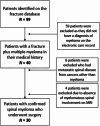A Comparative Study of the Outcomes of Surgically Versus Non-Surgically Treated Spinal Disease in Patients With Multiple Myeloma: Northern Ireland's Experience
- PMID: 40454384
- PMCID: PMC12126995
- DOI: 10.1002/jha2.70071
A Comparative Study of the Outcomes of Surgically Versus Non-Surgically Treated Spinal Disease in Patients With Multiple Myeloma: Northern Ireland's Experience
Abstract
Background: Multiple myeloma is a haematological malignancy which is characterised by the proliferation of cancerous plasma cells in the bone marrow. The role of spinal surgery in the management of myeloma is debatable. Therefore, this retrospective study aimed to compare the outcomes of treatment of patients with myeloma whose spinal disease was managed surgically and/or non-surgically.
Methods: A total of 159 patients were reviewed retrospectively. To compare the outcomes of treatment in both cohorts, three outcome measures were selected, including back-pain reduction, neurological status, and survival duration. In addition, the extent and distribution of vertebral disease was assessed using MRI Whole Spine reports.
Results: There was no significant difference in the percentage of patients in each cohort reporting back-pain pretreatment and at the two follow-up periods (p > 0.05). Regarding neurological status, 23% of the surgical cohort improved, 53% remained stable and 7% deteriorated. In comparison, the non-surgical cohort displayed no significant changes in neurological status post-treatment. The mean duration of survival was significantly longer in the cohort who received surgery (77 vs. 24 months, p = 0.014). However, the mean age of diagnosis was significantly lower in this cohort (59 vs. 71 years, p < 0.001). T12 was the most commonly diseased vertebral level across both cohorts. At the time of diagnosis, the average number of diseased vertebrae per patient was 3.5 in the surgical cohort and 3.6 in the non-surgical cohort.
Conclusion: This comparative study has shown that back pain alone should not be an indication for spinal surgery. However, surgical intervention may successfully prevent neurological deterioration. Although surgical intervention is associated with prolonged survival, this may be confounded by demographic variables, such as age. Importantly, most patients displayed multi-level disease at the time of diagnosis.
Trial registration: The authors have confirmed clinical trial registration is not needed for this submission.
Keywords: multiple myeloma; spinal disease; spinal surgery.
© 2025 The Author(s). eJHaem published by British Society for Haematology and John Wiley & Sons Ltd.
Conflict of interest statement
The authors declare no conflicts of interest.
Figures





Similar articles
-
Folic acid supplementation and malaria susceptibility and severity among people taking antifolate antimalarial drugs in endemic areas.Cochrane Database Syst Rev. 2022 Feb 1;2(2022):CD014217. doi: 10.1002/14651858.CD014217. Cochrane Database Syst Rev. 2022. PMID: 36321557 Free PMC article.
-
Primary pyogenic infection of the spine in intravenous drug users: a prospective observational study.Spine (Phila Pa 1976). 2012 Apr 15;37(8):685-92. doi: 10.1097/BRS.0b013e31823b01b8. Spine (Phila Pa 1976). 2012. PMID: 22037525
-
Balloon kyphoplasty: an evidence-based analysis.Ont Health Technol Assess Ser. 2004;4(12):1-45. Epub 2004 Dec 1. Ont Health Technol Assess Ser. 2004. PMID: 23074451 Free PMC article.
-
Long-term outcomes of surgical and nonsurgical management of lumbar spinal stenosis: 8 to 10 year results from the maine lumbar spine study.Spine (Phila Pa 1976). 2005 Apr 15;30(8):936-43. doi: 10.1097/01.brs.0000158953.57966.c0. Spine (Phila Pa 1976). 2005. PMID: 15834339
-
Systematic Review of Outcomes Following 10-Year Mark of Spine Patient Outcomes Research Trial for Intervertebral Disc Herniation.Spine (Phila Pa 1976). 2020 Jun 15;45(12):825-831. doi: 10.1097/BRS.0000000000003400. Spine (Phila Pa 1976). 2020. PMID: 32004232
References
-
- Molloy S., Lai M., Pratt G., et al., “Optimizing the Management of Patients With Spinal Myeloma Disease,” British Journal of Haematology 171, no. 3 (2015): 332–343. - PubMed
-
- Ramsenthaler C., Kane P., Gao W., et al., “Prevalence of Symptoms in Patients With Multiple Myeloma: A Systematic Review and Meta‐Analysis,” European Journal of Haematology 97, no. 5 (2016): 416–429. - PubMed
-
- Jonsson B., Sjöström L., HalldÓR Jónsson J., and Karlström G., “Surgery for Multiple Myeloma of the Spine: A Retrospective Analysis of 12 Patients,” Acta Orthopaedica Scandinavica 63, no. 2 (2009): 192–194. - PubMed
LinkOut - more resources
Full Text Sources
